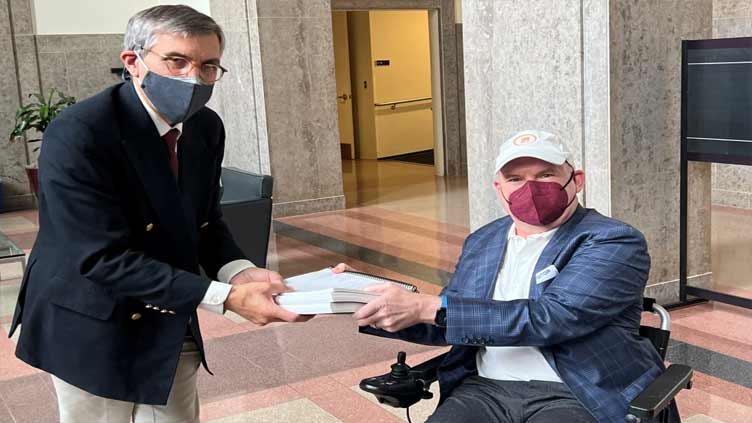Experimental treatment pushed by ALS patients gets day before FDA, but agency unconvinced it works

Those advocates still face one giant hurdle
WASHINGTON (AP) — The Food and Drug Administration meets this week to consider approval of an experimental treatment for Lou Gehrig’s disease, the culmination of a yearslong lobbying effort by patients with the fatal neurodegenerative disease.
Those advocates still face one giant hurdle: FDA regulators say the treatment hasn’t been shown to work.
In documents posted Monday, the FDA reiterated its longstanding position that a lone study by drugmaker Brainstorm doesn’t provide convincing evidence that its stem cell-based therapy helps patients with ALS, or amyotrophic lateral sclerosis.
It’s the same message the FDA delivered to company executives in early 2021 when they first shared data on the treatment, dubbed NurOwn. And again last November, when the FDA refused to accept the company’s application for review.
But with the backing of thousands of ALS patients, Brainstorm took the rare step of “filing over protest,” essentially forcing the agency to render a decision.
“FDA is the 800-pound gorilla here and if they’re convinced that the drug doesn’t work it’s very hard to change their minds,” said Marc Scheineson, a former associate FDA commissioner who now consults for drugmakers.
In the documents posted Monday, FDA reviewers outlined their “major concerns” about the company’s evidence.
Still, ALS patients see reasons for optimism.
Under pressure from the ALS community and Congress, FDA officials have recently emphasized the “urgent need” for new ALS treatments and pledged to use maximum “regulatory flexibility” when reviewing them. FDA has approved two new ALS drugs in the last year, neither of which met the agency’s traditional approval standards.
NurOwn is the clearest test yet of how far the agency may be willing to bend to approve a new medicine for a rare and deadly condition with few treatment options.
ALS gradually destroys nerve connections needed for basic movements and functions, including breathing. Most people die within five years of diagnosis.
At Wednesday’s meeting, federal advisers will hear from FDA scientists, company researchers and patients before taking a non-binding vote on NurOwn’s effectiveness. FDA will make the final decision on the therapy later this year.
The meeting was scheduled after ALS advocates delivered a 30,000-signature petition seeking a public vetting of the treatment.
Brian Wallach, co-founder of the advocacy group I AM ALS, says even if NurOwn only provides a small benefit for some patients, it should be made available. A former Obama White House staffer, Wallach was diagnosed with ALS in 2017.
“We do not want the perfect to be the enemy of the good,” said Wallach, speaking through an interpreter. “The key is to have treatments that make it possible to turn ALS into more of a chronic disease and to allow all patients to live longer and hopefully see a cure.”
Still, there’s little consensus on NurOwn among the normally tight-knit ALS community.
The ALS Association, the largest organization in the field, has not endorsed Brainstorm’s bid for approval despite giving the company $400,000 in research funding. Brainstorm declined to make its complete dataset available for external review, a spokesperson noted.
“The amazing testimonials we have seen online do not align with the data that Brainstorm has shared,” the group said in a statement.
At Wednesday’s meeting, people with such reservations are certain to be outnumbered by appeals from ALS patients and their families. The FDA has received more than 1,900 written comments, many expressing outrage that NurOwn was not approved years ago.
“If we would’ve had NurOwn approved back when I was still walking, I believe I might still be walking today,” wrote Patricia Manhardt, who was diagnosed in 2020.
NurOwn is made from stem cells collected from patients’ bone marrow. The cells are processed in a lab with biological proteins designed to promote nerve growth, and then injected into the spinal column.
In a study of 200 patients, NurOwn failed to show a statistically significant difference between patients who received the drug and those who got sham injections. Brainstorm and the academic researchers who conducted the study say the results were skewed by an unexpectedly high number of patients with advanced disease who enrolled in the trial.
ALS is measured using a 48-point questionnaire that tracks functions like walking, swallowing and handwriting.
On Wednesday, researchers will tell FDA that because many patients declined so quickly on the scale, the study failed to show Nurown’s effect on progression. When data from a small subset of healthier patients is isolated, they argue, NurOwn significantly slowed the disease.
“The leaders in this field have said there’s more to this story than just, ‘No it doesn’t work,’” said Dr. Anthony Windebank, a Mayo Clinic neurologist who will present on Brainstorm’s behalf.
But FDA reviewers said Monday the company’s theory does not explain the study’s failed results.
Physicians who weren’t involved in the research suggest regulators might be willing to make a compromise: approving NurOwn for some patients while awaiting more definitive results.
“I don’t want to lose a potential treatment for ALS, but I also don’t want to foist on the public an expensive treatment that doesn’t work,” said Dr. Terry Heiman-Patterson of Temple University.
That compromise would be similar to FDA’s approach to Relyvrio last year, another ALS drug with questionable data. But in that case, the drugmaker had started its follow-up study long before approval.
Brainstorm has not begun a second study, saying it’s been unable to raise enough money.
Meanwhile, FDA observers worry about the long-term consequences if regulators keep accepting weaker evidence from drugmakers.
“If the standards fall too low, that sends a message to industry that you don’t have to prove your drug works,” said Holly Fernandez Lynch, a bioethicist at University of Pennsylvania. “It’s understandable why some patients would accept that. But if that becomes the regulatory standard, it can set back a field in the long term.”


